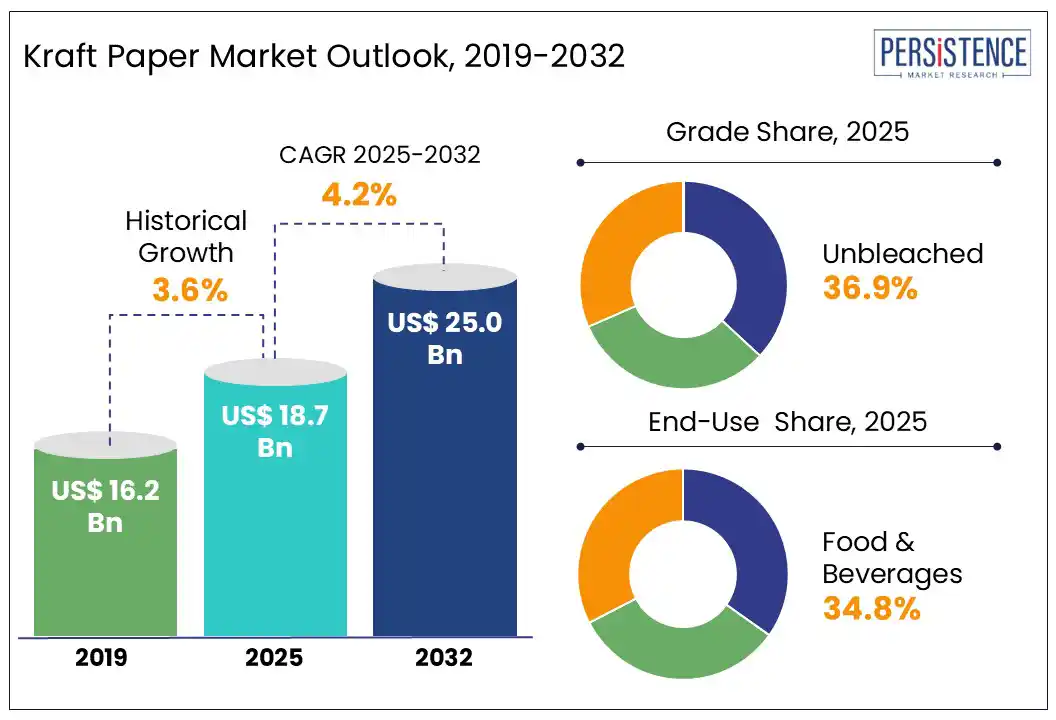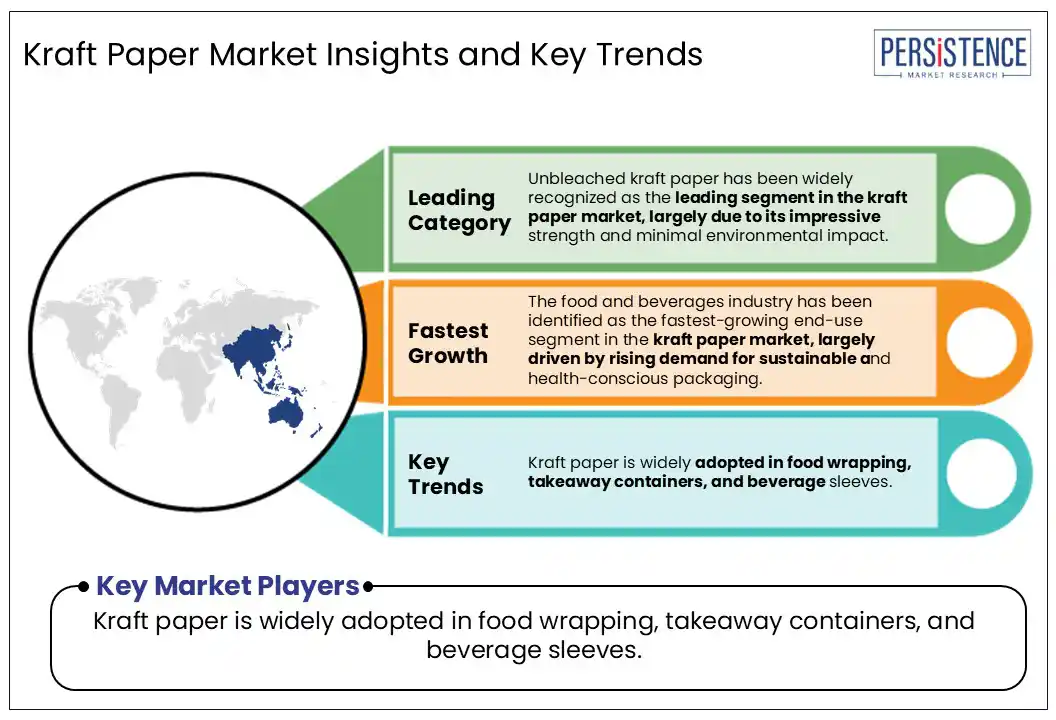ID: PMRREP34409| 194 Pages | 8 Jul 2025 | Format: PDF, Excel, PPT* | Packaging

The global Kraft Paper market size is likely to value at US$ 18.7 billion in 2025 and is expected to reach US$ 25.0 billion by 2032, reflecting a CAGR of 4.2% during the forecast period from 2025 -2032.
The kraft paper market is driven by the rising demand for sustainable, recyclable, and biodegradable packaging solutions. Kraft paper is widely used in the food and beverage, construction, and retail sectors due to its strength, durability, and eco-friendly properties. Increasing environmental regulations and a growing consumer preference for alternatives to plastic are further fueling market expansion in both developed and emerging economies.

Key Industry Highlights:
|
Global Market Attribute |
Key Insights |
|
Kraft Paper Market Size (2025E) |
US$ 18.7 Bn |
|
Market Value Forecast (2032F) |
US$ 25.0 Bn |
|
Projected Growth (CAGR 2025 to 2032) |
4.2% |
|
Historical Market Growth (CAGR 2019 to 2024) |
3.6% |
Global paper consumption is growing as the preference for sustainable and biodegradable packaging has significantly fueled the demand for kraft paper. Consumers increasingly prioritize eco-friendly choices over plastic alternatives. This shift in behavior, largely influenced by heightened awareness of environmental impacts and non-recyclable waste, has prompted businesses across sectors to integrate kraft paper into their packaging strategies. Valued for its recyclability, biodegradability, and lower carbon footprint, kraft paper is being widely adopted as industries seek to align with sustainability goals.
In 2025, Mondi Group certified its entire kraft paper portfolio as compostable, supporting its commitment to ensure all packaging and paper products are reusable, recyclable, or compostable by 2025. Made from renewable sources, Mondi’s kraft papers help customers achieve their environmental goals.
These efforts highlight how manufacturers are adapting to meet the rising demand for environmentally responsible packaging solutions.
A distinctive challenge confronting the global kraft paper market has been the inferior barrier properties of kraft paper in comparison to materials made from plastic. Although kraft paper is favored for its sustainability, its inability to provide effective moisture, grease, and air resistance has restricted its adoption in packaging applications requiring high-performance protection—such as in frozen foods, pharmaceuticals, and liquid containers. To compensate, additional coatings or lamination layers are often required, which can compromise recyclability and raise production costs.
This trade-off between functionality and sustainability has presented a significant challenge for manufacturers attempting to meet both environmental and performance expectations. Customers seeking sustainable solutions have often been forced to choose between eco-friendliness and product safety, creating hesitation among certain end-users. As industries demand packaging that meets increasingly stringent safety and performance standards, the need to overcome kraft paper’s inherent material limitations has become a pressing concern that continues to slow its broader market penetration.
Opportunities have been created in the kraft paper market due to the rising demand for sustainable e-commerce packaging solutions. As online retail has rapidly expanded, the need for durable, biodegradable, and visually appealing materials has been increasingly emphasized. Kraft paper has been widely adopted for its strength and eco-friendliness, meeting both protective and environmental criteria. Customization options have been pursued to boost brand recognition and improve unboxing experiences. In response, manufacturers have been driven to develop innovative designs tailored to evolving e-commerce logistics and consumer expectations.
In 2025, DS Smith launched its “Tape Back” solution—an e-commerce packaging design that eliminates plastic tear strips in favor of a reusable adhesive strip. This approach has not only simplified returns but also improved recyclability. Through such innovations, kraft paper has been positioned as a critical solution in the transition away from plastic, aligning with circular economy goals and rising consumer consciousness.
Unbleached kraft paper has been widely recognized as the leading segment in the kraft paper market, largely due to its impressive strength and minimal environmental impact. Its natural brown color, preserved through limited processing, reflects a commitment to eco-friendly manufacturing practices. This type of paper has been commonly used in demanding applications such as sacks and industrial wrapping, where durability is essential. Its recyclability and biodegradability have continued to resonate with both manufacturers and environmentally conscious consumers.
In 2025, WestRock opened a corrugated box plant in Pleasant Prairie, Wisconsin, focusing on unbleached kraft paper. The facility aims to enhance production efficiency while reducing energy use and waste, showcasing unbleached kraft paper as a sustainable and performance-driven packaging choice that meets market expectations.
The food and beverages industry has been identified as the fastest-growing end-use segment in the kraft paper market, largely driven by rising demand for sustainable and health-conscious packaging. As consumers become more aware of the environmental and health impacts of plastic, kraft paper has been increasingly adopted for food wraps, takeaway containers, and other packaging solutions. Its natural, biodegradable, and recyclable qualities make it an ideal choice for maintaining food safety while minimizing environmental harm.
In 2025, DS Smith launched its “GoChill Cooler,” a 100% recyclable and reusable alternative to traditional plastic and Styrofoam coolers. Made from wax-free corrugated board, the cooler was designed to keep food and beverages fresh while reducing waste and carbon emissions.
This reflects the global paper packaging market’s broader shift toward sustainable packaging in everyday food consumption.

Kraft paper consumption in North America is being accelerated by the shift toward paper-based grocery and retail bags, largely influenced by tightening environmental regulations and rising consumer concern over plastic pollution. With numerous U.S. states and municipalities enacting bans or restrictions on single-use plastic bags, retailers have been compelled to transition to more sustainable alternatives like kraft paper.
California’s statewide ban on plastic bags, taking effect in January 2026, mandates the use of paper or reusable options in retail environments. This legislative push, alongside public preference for eco-friendly packaging, is reshaping market dynamics in favor of kraft paper.
In the U.S. kraft paper market, companies like DS Smith have developed solutions such as the "Shop.able Carrier," a recyclable and reusable box designed to replace plastic bags in supermarkets. This initiative, aligned with the "Beyond the Bag" movement and supported by legislation in 18 U.S. states, reflects how regulatory and consumer forces are together fueling kraft paper demand.
In 2025, Europe Kraft Paper market, a notable shift toward paper-based grocery and retail bags is being witnessed across Europe, largely driven by stricter environmental regulations and heightened consumer demand for sustainable packaging. The European Union's Packaging and Packaging Waste Regulation, which came into effect in January 2025, mandates that all packaging introduced to the EU market must be recyclable by both design and composition.
This initiative, aimed at reducing waste and supporting a circular economy, has led to an increased reliance on kraft paper as a viable, eco-friendly alternative to plastic, especially within the food and beverage sector. These proactive efforts are not only helping to meet regulatory requirements but also reflecting growing public expectations for environmentally responsible packaging options in everyday retail.
DS Smith is also enhancing its role in the region, investing €25 million to upgrade its facility in Poland with advanced fiber-based packaging machinery. These efforts reflect a regional shift toward sustainability, meeting both regulatory demands and consumer expectations.
In 2025, Kraft paper consumption is surging across the Asia Pacific region, fueled by rapid urbanization and growing demand for packaged food. As more people gravitate toward convenient, ready-to-eat meals, especially in urban centers, the need for sustainable packaging solutions has intensified. The expansion of e-commerce and food delivery services is further driving this shift, placing kraft paper in high demand due to its strength and eco-friendly properties.
Governments are reinforcing the trend by introducing stricter regulations to curb plastic waste, making kraft paper a preferred alternative. Companies like International Paper are responding by broadening their footprint in Asia, offering sustainable products such as pulp, containerboard, and SpaceKraft®, while maintaining a strong commitment to environmental responsibility.
The global kraft paper market is characterized by the presence of several established manufacturers competing on the basis of product quality, sustainability, regional reach, and customization capabilities. Leading players such as International Paper Company, WestRock Company, DS Smith Plc, Canfor Corporation, and Mondi Group Plc have been actively expanding their production capacities and introducing eco-friendly innovations to cater to the rising demand for biodegradable packaging. These companies focus on sustainable sourcing, product differentiation, and advanced manufacturing technologies to maintain market competitiveness.
Regional players like Gascogne Papier and Natron-Hayat d.o.o. strengthen their positions by offering specialized kraft grades and customized formats for local and export markets. Strategic initiatives such as mergers, acquisitions, capacity expansions, and product launches are being leveraged to capture untapped geographies and emerging end-use industries. The competitive landscape is further shaped by stringent environmental regulations, which drive companies to invest in greener technologies and raw material sourcing strategies.
The global Kraft Paper market is projected to be valued at 18.7 bn in 2025.
The Kraft Paper market is driven by growing consumer preference for sustainable and biodegradable packaging is boosting kraft paper demand.
The Kraft Paper market is poised to witness a CAGR of 4.2% from 2025 to 2032.
Rising e-commerce packaging needs create strong opportunities for customized kraft paper solutions is the key market opportunity.
Major players in the Kraft Paper market include WestRock Company, Mondi Group Plc., Canfor Corporation, Natron-Hayat d.o.o., International Paper Company, DS Smith Plc, and others.
|
Report Attributes |
Details |
|
Historical Data/Actuals |
2019 - 2024 |
|
Forecast Period |
2025 - 2032 |
|
Market Analysis Units |
Value: US$ Bn, Volume: Tons |
|
Geographical Coverage |
|
|
Segmental Coverage |
|
|
Competitive Analysis |
|
|
Report Highlights |
|
|
Customization and Pricing |
Available upon request |
By Product Type
By Grade
By End-Use
By Region
Delivery Timelines
For more information on this report and its delivery timelines please get in touch with our sales team.
About Author